A conducting rod PQ of length 20 cm and resistance 0.1Ω rests on two smooth parallel rqails of negligible resistance AA' and CC'. It can slide on the rails and the arrangement is positioned betwaeen the poles of a permanent magnet producing unifrom magnetic field B=0.4 T. The rails, the rod and the magneitc field are in the three mutually perpendicular directions as shown in the figure. if hte ends A and C of the rails are short cicuited, find the
External force required to move the rod with uniform velocity v=10cm/s.Solution in Punjabi
Step by step video & image solution for A conducting rod PQ of length 20 cm and resistance 0.1 Omega rests on two smooth parallel rqails of negligible resistance AA' and CC'. It can slide on the rails and the arrangement is positioned betwaeen the poles of a permanent magnet producing unifrom magnetic field B=0.4 T. The rails, the rod and the magneitc field are in the three mutually perpendicular directions as shown in the figure. if hte ends A and C of the rails are short cicuited, find theExternal force required to move the rod with uniform velocity v=10cm/s. by Physics experts to help you in doubts & scoring excellent marks in Class 12 exams.
Similar Questions
A metal rod PQ is resting on the rails A'B' and positioned between the poles of a permanent magnet. The rails, the rod and the magnetic field are in three mutually perpendicular directions. A galvanometer G connects the rails through a switch K. Length of the rod = 15 cm, B = 0.50 T, resistance of the closed loop containing the rod = 9.0mΩ. Assume the field to be uniform.
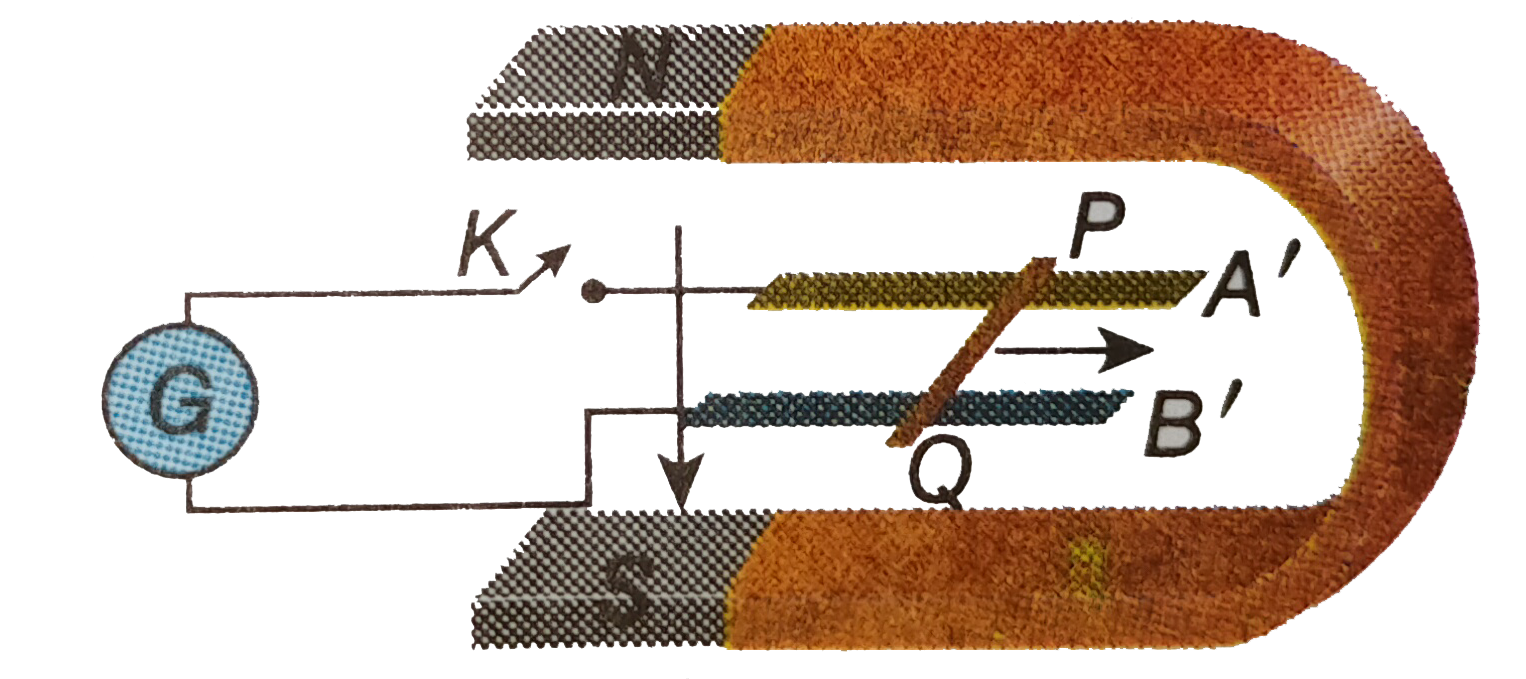
With K open and the rod moving uniformly, there is no net force on the electrons in thr rod PQ even though they do experience magnetic force due to the motion of the rod. Explain.07:42View Solution(a) With the help of a labelled digram, explain the working of a step-up transformer. Give reason to explain the following,
(i) The core of the transformer is laminated.
(ii) Thick copper wire is used in windings.
(b) A conducting rod PQ of length 20 cmn and resistance 0.1Ω rests on two smooth parallel rails of negligible resistance AA' and CC'. It can slide on the rails and the arrangement is positioned between the poles of a permanent magnet producing uniform magnetic field B=0.4T. The rails, the rod and the magnetic field are in three mutually perpendicular directions as shown in the figure. If the ends A and C of the rails are short circuited, find the
(i) external force required to move the rod with uniform velocity v= 10 cm/s, and
(ii) power required to do so.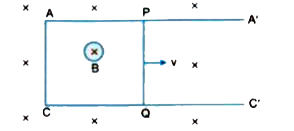 View Solution
View SolutionFigure shows a conducting rod of negligible resistance that can slide on smooth U-shaped rail made of wire of resistance 1Omega//m . Position of the conducting rod at t=0 is shown. A time dependent magnetic field B=2t tesla is switched on at t=0 The current in the loop at t=0 due to induced emf is
02:44View SolutionFigure 6.20 shows a metal rod PQ resting on the smooth rails AB and positioned between the poles of a permanent magnet. The rails, the rod, and the magnetic field are in three mutual perpendicular directions. A galvanometer G connects the rails through a switch K. Length of the rod =15 cm, B = 0.50 T, resistance of the closed loop containing the rod=9.0mΩ Assume the field to be uniform. Suppose K is open and the rod is moved with a speed of 12cms−1 in the direction shown. Give the polarity and magnitude of the induced emf. :
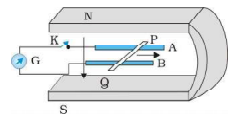 04:18View Solution
04:18View SolutionFigure shows a metal rod PQ resting on the smooth rails AB and positioned between the poles of a permanent magnet. The rails, the rod, and the magnetic field are in three mutual perpendicular directions. A galvanometer G connects the rails through a switch K. Length of the rod =15 cm, B = 0.50 T, resistance of the closed loop containing the rod=9.0mΩ Assume the field to be uniform. Is there an excess charge built up at the ends of the rods when K is open? What if K is closed? :
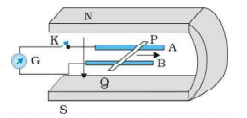 02:05View Solution
02:05View SolutionFigure 6.20 shows a metal rod PQ resting on the smooth rails AB and positioned between the poles of a permanent magnet. The rails, the rod, and the magnetic field are in three mutual perpendicular directions. A galvanometer G connects the rails through a switch K. Length of the rod =15 cm, B = 0.50 T, resistance of the closed loop containing the rod=9.0mΩ Assume the field to be uniform. With K open and the rod moving uniformly, there is no net force on the electrons in the rod PQ even though they do experience magnetic force due to the motion of the rod. Explain. :
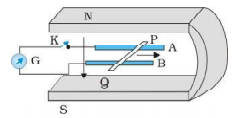 03:06View Solution
03:06View SolutionFigure shows a metal rod PQ resting on the smooth rails AB and positioned between the poles of a permanent magnet. The rails, the rod, and the magnetic field are in three mutual perpendicular directions. A galvanometer G connects the rails through a switch K. Length of the rod =15 cm, B = 0.50 T, resistance of the closed loop containing the rod = 9.0 mOmega Assume the field to be uniform. What is the retarding force on the rod when K is closed? :
02:25View SolutionFigure shows a metal rod PQ resting on the smooth rails AB and positioned between the poles of a permanent magnet. The rails, the rod, and the magnetic field are in three mutual perpendicular directions. A galvanometer G connects the rails through a switch K. Length of the rod =15 cm, B = 0.50 T, resistance of the closed loop containing the rod=9.0mΩ. Assume the field to be uniform and the rod is moved with a speed of 12 cm/s. How much power is dissipated as heat in the closed circuit? What is the source of this power? :
 02:53View Solution
02:53View Solution

